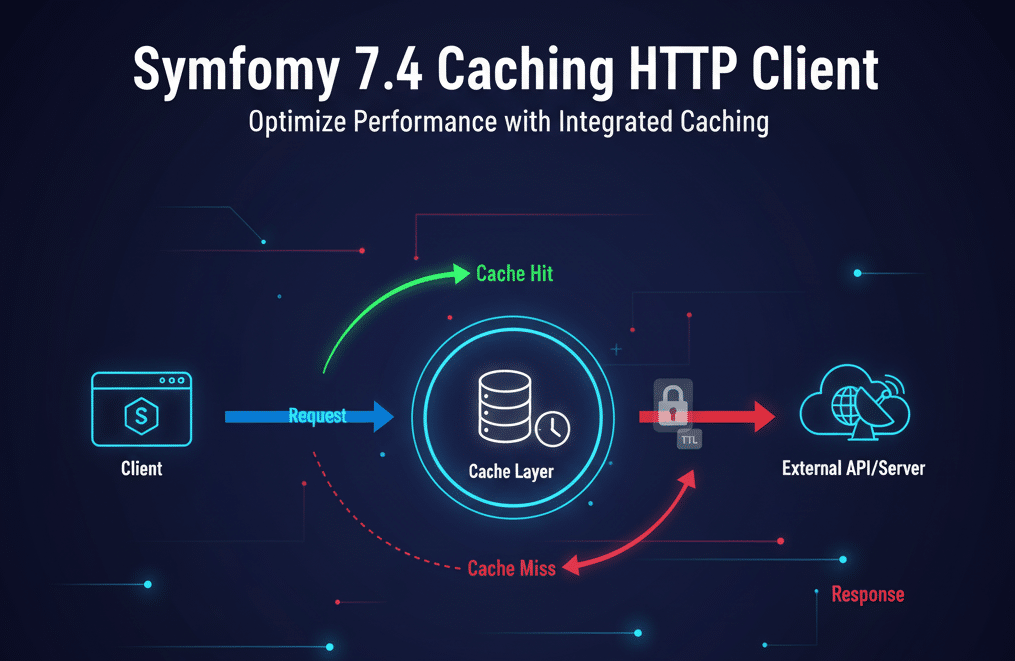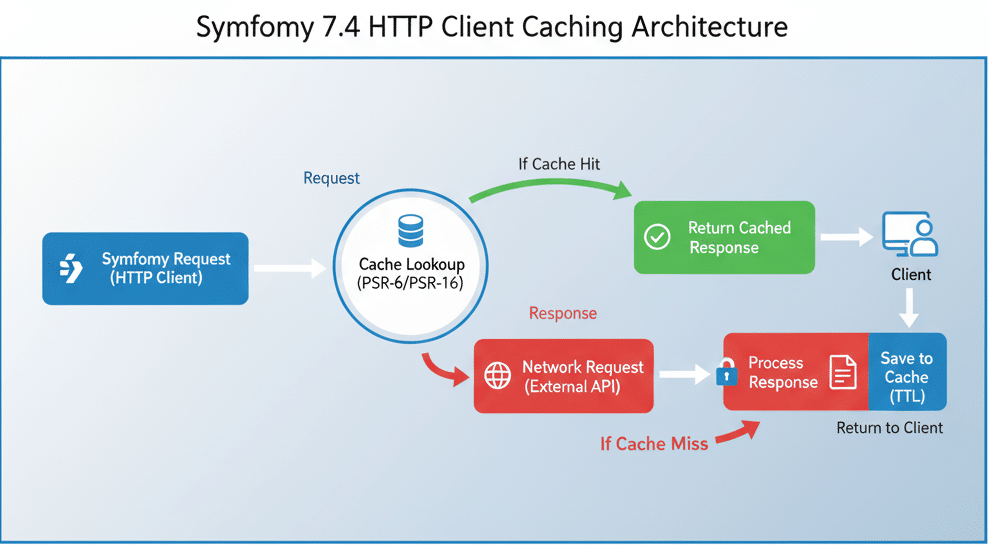
New in Symfony 7.4: Caching HTTP Client That Supercharges Your App’s Performance
Performance is everything in modern web development. Whether you’re building large-scale enterprise software or lightweight APIs, Symfony 7.4 is here to make your life easier. The highlight of this release? The Caching HTTP Client, a built-in feature that automatically stores and reuses API responses, saving both time and bandwidth.
In this blog, we’ll explore what makes the Symfony 7.4 Caching HTTP Client so powerful, how to implement it, and why it’s a game-changer for Symfony performance optimization.
Table of Contents
The Performance Challenge in Modern Symfony Apps
Developers often face a common bottleneck, repetitive HTTP requests to the same external APIs or microservices. These calls consume resources, increase response time, and put unnecessary load on servers.
Traditionally, caching was handled externally using tools like Redis or application-level wrappers. But with Symfony 7.4’s new Caching HTTP Client, you get caching built right into the framework’s core making it both efficient and effortless.
Introducing the Caching HTTP Client in Symfony 7.4
The new Caching HTTP Client acts as a transparent layer that intercepts HTTP requests and responses. When a request is made, Symfony first checks if a cached version exists. If yes, it serves the cached response instantly, if not, it performs the request and saves the result for future use.
Key Benefits:
- Improved Performance – Reduce latency and network overhead.
- Automatic Reuse – Cache responses for repeated calls.
- Built-in Efficiency – No need for external caching libraries.
- Full Control – Configure TTL (time-to-live), cache store, and invalidation.
This new feature streamlines Symfony performance optimization without modifying existing client code significantly.

How It Works (with Code Example)
Here’s a quick example of how to use the new Caching HTTP Client in Symfony:
use Symfony\Component\HttpClient\CachingHttpClient;
use Symfony\Component\HttpClient\HttpClient;
use Symfony\Component\Cache\Adapter\FilesystemAdapter;
$store = new FilesystemAdapter();
$client = new CachingHttpClient(HttpClient::create(), $store);
$response = $client->request('GET', 'https://api.example.com/data');
$content = $response->getContent();
In this setup:
- The
FilesystemAdapterstores cached responses locally. - The
CachingHttpClientwraps around the standardHttpClient. - Symfony automatically handles cache lookup, freshness, and invalidation.
This means developers can integrate Symfony cache directly into their existing HTTP workflow with minimal setup.
Reference: Caching HTTP Client
Configuration in framework.yaml
You can also configure the caching behavior globally:
framework:
http_client:
default_options:
cache: true
timeout: 10
max_redirects: 5
Or specify a custom cache pool:
framework:
http_client:
default_options:
cache: 'app.cache.http'
This makes Symfony configuration simple and consistent across environments.
Real-World Use Cases
Here are some common scenarios where Symfony’s Caching HTTP Client shines:
- API Integrations – Cache responses from slow third-party APIs to enhance responsiveness.
- Microservice Communication – Reduce network chatter between services.
- Frontend Backends (BFFs) – Deliver cached responses to React/Vue frontends quickly.
- Rate-Limited APIs – Avoid hitting rate limits by caching repeat requests.
Each use case directly contributes to performance optimization in Symfony applications.
Best Practices & When Not to Use It
While caching boosts performance, it’s not ideal for every scenario. Avoid caching when:
- You’re dealing with real-time data (like stock prices or chat messages).
- APIs return user-specific or sensitive information.
- You require dynamic responses that must always be fresh.
A good practice is to define cache headers or TTL settings that align with your business logic.
Comparison with Older Approaches
Before Symfony 7.4, developers often relied on manual caching or HTTP client decorators. While functional, they required additional setup, maintenance, and testing.
Now, the Symfony 7.4 Caching HTTP Client does all the heavy lifting – it’s consistent, easy to configure, and fully integrated into the framework. No more third-party dependencies or complex caching layers.
How to Upgrade to Symfony 7.4 Safely
Upgrading to Symfony 7.4 is straightforward if you follow the right process. Here’s a quick checklist:
- Check PHP Compatibility – Ensure you’re running PHP 8.2 or higher.
- Update Composer – Run
composer update symfony/*. - Review Deprecated Code – Use Symfony’s deprecation logs.
- Run Tests – Validate using PHPUnit or your preferred testing suite.
- Enable the Caching HTTP Client – Start integrating it gradually.
This Symfony upgrade guide ensures minimal downtime and smooth migration from Symfony 7.3.
Conclusion & Key Takeaways
Symfony 7.4 marks a significant milestone in performance optimization. The new Caching HTTP Client simplifies caching, improves response time, and helps developers focus on building rather than optimizing.
If you haven’t yet explored this feature, now’s the time. Upgrade, experiment, and experience just how much faster your Symfony apps can be.
You can check other interesting content at by Clicking here.
